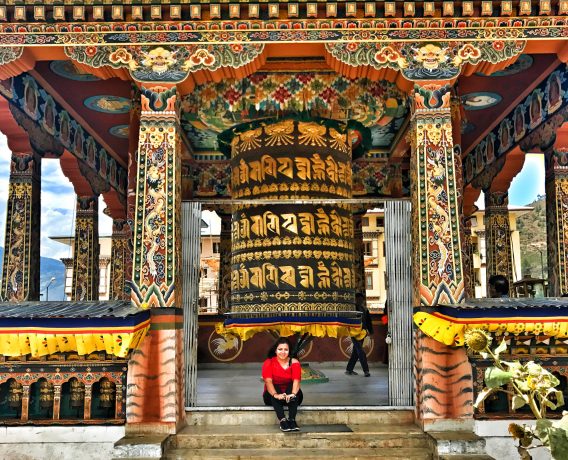In June 2017, I had a somewhat difficult decision to make. I was living in Nepal and I had to decide where to go to Bhutan on a solo trip or go back to Bangladesh to celebrate Eid with my family. Of course, being the adventure junkie that I am, I chose the former. I had never been to Bhutan and having heard so much about the country, I just had to go! Let me give you some context here: with the Bangladeshi passport, there are currently only 38 countries across the world that we receive either visa on arrival or e visa in, but we have one perk, we get visa free access to Bhutan!
The thing I loved most about Bhutan, well before my trip into the country, is the effort the country makes to conserve it’s environment. The philosophy behind this tourism policy is extremely well thought out and focuses on the welfare of the people of the country. In fact, a percentage of the earnings from tourism is dedicated to the free health care and education that all bhutanese citizens enjoy.


I got to Bhutan in a plane full of angry tourists, all of whom were ticked off by the flight delay as they were losing out on high amount of money they paid. The flight touched down in Bhutan’s only international airport, just after sunset and honestly, this landing was super scary. The runway in Paro Airport is just impossible, if the pilot is not specifically trained for this exact runway, there is a 8324898365% chance that the plane might crash! Which probably explains why Bhutan Airways and Druk Airways are the only commercial planes allowed to fly in and out of the country.
I landed in Bhutan and that night, did not do much, given the delay of my flight. I was being hosted for the night at a family friend’s place who had organised a guide for me to be shown around Bhutan. A small mistake I made while at immigration was that I told them I was coming to see a friend, which meant that they did not give me the permit I needed. If you are Bangladeshi, Indian or Maldivian coming to visit friends, please be sure to mention that you are a tourist, to ensure that you have the proper permits. The next day, after sorting out my permit (which was free of cost), we headed out to Dochula which is one of the highest passes in Bhutan.
 The view was wonderful throughout the drive and the air was just amazing to breathe. Having lived in Kathmandu for almost a year at the point, I had gotten used to the terrible quality of air, I did not realise until i got to Bhutan, how absolutely fresh the air was. Once we got to the top of the hill, things got somewhat more hazy, it was not a clear day and so we could not see the mountain range. But after a small breakfast, the guide took me to the “Druk Wangyel Chortens” – (pictured behind me) which are monuments built to commemorate the victory over “terrorists” (trying my best not to be political here, therefore the inverted comas).
The view was wonderful throughout the drive and the air was just amazing to breathe. Having lived in Kathmandu for almost a year at the point, I had gotten used to the terrible quality of air, I did not realise until i got to Bhutan, how absolutely fresh the air was. Once we got to the top of the hill, things got somewhat more hazy, it was not a clear day and so we could not see the mountain range. But after a small breakfast, the guide took me to the “Druk Wangyel Chortens” – (pictured behind me) which are monuments built to commemorate the victory over “terrorists” (trying my best not to be political here, therefore the inverted comas).
 From here, we headed to “Chimmi Lakhang”, this is a monastery that is particularly famous for granting reproductive favours to childless couples (lol, like is there a not weird way of saying this?) Anyway, this is when I experienced my first culture shock. While trekking through the village up to the monastery, I saw an array of wooden phalluses on shop windows that look like medieval sex toys, paintings of phalluses all over the buildings/houses and actual souvenirs of phalluses in small shops and such. Seriously, I was at awe because I have honestly never seen anything like this before!
From here, we headed to “Chimmi Lakhang”, this is a monastery that is particularly famous for granting reproductive favours to childless couples (lol, like is there a not weird way of saying this?) Anyway, this is when I experienced my first culture shock. While trekking through the village up to the monastery, I saw an array of wooden phalluses on shop windows that look like medieval sex toys, paintings of phalluses all over the buildings/houses and actual souvenirs of phalluses in small shops and such. Seriously, I was at awe because I have honestly never seen anything like this before!
 When I finally got to the monastery, i felt a sense of peace that was almost etheral and other worldly. I sat down on a bench and decided to meditate and somehow found myself in the middle of a photo session. A group of old korean ladies who were at the monastery at the time found me amusing and took a bunch of photos (picture on the left), which they later shared with me – (yay, my claim to fame?). The monastery has a very interesting story, it was built in honour of a “divine mad man”, he used very unorthodox, bizzare and sometimes downright outrageous methods, much of which had sexual undertones, to invoke people’s interest in Buddhism.
When I finally got to the monastery, i felt a sense of peace that was almost etheral and other worldly. I sat down on a bench and decided to meditate and somehow found myself in the middle of a photo session. A group of old korean ladies who were at the monastery at the time found me amusing and took a bunch of photos (picture on the left), which they later shared with me – (yay, my claim to fame?). The monastery has a very interesting story, it was built in honour of a “divine mad man”, he used very unorthodox, bizzare and sometimes downright outrageous methods, much of which had sexual undertones, to invoke people’s interest in Buddhism.
 From this monastery, we had small pit stop for lunch at a beautiful restaurant serving delicious food and and incredible view (picture on the right) headed to Punakha Dzong. On the way to Punakha Dzong, we stopped at a small town (pictured below) which was a very interesting way to see the Bhutanese way of life.
From this monastery, we had small pit stop for lunch at a beautiful restaurant serving delicious food and and incredible view (picture on the right) headed to Punakha Dzong. On the way to Punakha Dzong, we stopped at a small town (pictured below) which was a very interesting way to see the Bhutanese way of life.
 I learnt that in Bhutan, they practice no slaughter months, which basically means that there are months that Bhutanese people neither slaughter, nor sell raw meat anywhere. There were entire meat shops closed down during these periods. It is done as a way to promote less consumption of meat, which worked perfectly for me, since I was
I learnt that in Bhutan, they practice no slaughter months, which basically means that there are months that Bhutanese people neither slaughter, nor sell raw meat anywhere. There were entire meat shops closed down during these periods. It is done as a way to promote less consumption of meat, which worked perfectly for me, since I was
already a vegetarian at that point. I also saw outdoor park gyms, installed by the government and local markets, where people buy and sell fresh vegetables, fruits and other foods.
 From here, we headed to Punakha Dzong, now this was a beautiful experience. The entire structure is fascinating and beautiful. It used to be the administrative centre and the seat of the Bhutanese Government till 1955 and still functions as an administrative centre for the Punakha district. The Dzong itself is majestic with a backdrop of emerald mountains, it looks even more beautiful. There are two historical courtyards, both large and beautiful.
From here, we headed to Punakha Dzong, now this was a beautiful experience. The entire structure is fascinating and beautiful. It used to be the administrative centre and the seat of the Bhutanese Government till 1955 and still functions as an administrative centre for the Punakha district. The Dzong itself is majestic with a backdrop of emerald mountains, it looks even more beautiful. There are two historical courtyards, both large and beautiful.
 Since 2016, I have become a very spiritual person, it has changed my outlook on life completely and made me shift massively. I now believe that every so called mythical tale or story that has been passed down for centuries hold lessons for us to learn. And on the drive back, the only thing that I could not think of was the fact that someone (or some people) hundreds of years ago decided that these stories are important.
Since 2016, I have become a very spiritual person, it has changed my outlook on life completely and made me shift massively. I now believe that every so called mythical tale or story that has been passed down for centuries hold lessons for us to learn. And on the drive back, the only thing that I could not think of was the fact that someone (or some people) hundreds of years ago decided that these stories are important.
They found these stories so important that they painted them on the walls in great detail. While these tales can often seem very far fetched sometimes, I think that is the case because we take everything literally. Within these ancient tales there are lessons for us to learn. The painting for example speaks of the karmic repercussions of our actions, not necessarily for 7 life times, but maybe just this time life time. It made me a little bit more conscious about my actions and their consequences and reminded me to be kinder, on myself and everyone and everything i come across.
I hope this post has been useful and informative for you! If you can think of any topics you want me to write about please be sure to email me on : malihaaroundtheworld@gmail.com. And if you like this article, please show a sister some love, head over to instagram and follow my page: @maliharoundtheworld:D
Maliha Fairooz is a 27-year-old Bangladeshi solo traveller, who has travelled to 83 countries, on a Bangladeshi passport. Through her blog www.maliharoundtheworld.com, she shares her experience of travelling as a brown, Muslim, Bangladeshi woman while simultaneously encouraging a culture of travel amongst Bangladeshi youth.
